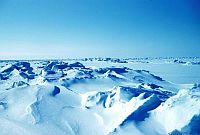Thursday, April 25, 2024
News and Views from the Global South
CLIMATE CHANGE: Earth’s Fridge Defrosting, With Dire Results
Stephen Leahy
- The rapidly warming Arctic region is destabilising Earth’s climate in ways science is just beginning to comprehend.

Winter sea ice terrain of the Beaufort Sea, Alaska. The Arctic Ocean may be ice-free in less than a decade. Credit: NOAA
“It is crucial to know the full consequences of the Arctic warming, and this is an unprecedented review of the latest science,” said Martin Sommerkorn, an Arctic researcher and senior climate change advisor to World Wildlife Fund International.
“Simply put, if we do not keep the Arctic cold enough, people across the world will suffer the effects,” Sommerkorn told IPS.
Sea level rise of more than one metre, flooding affecting one quarter of the world’s population, and extreme global weather changes are on the way at the current pace of unchecked carbon emissions, the “Arctic Climate Feedbacks: Global Implications” report warns.
A warming Arctic has far wider and more serious consequences than previously believed based on the latest science of the past three years, including the very recent research from International Polar Year 2008-2009.
“There is a large potential that a warming Arctic will make climate change far worse,” said Sommerkorn, who acted as editor of the report written by 10 of the world’s leading climate scientists.
The planet’s cold polar regions are crucial drivers of Earth’s weather and climate. Over the past 40 years, the Arctic has begun to thaw, with warmer temperatures that are rising at twice the rate as anywhere else in the world. Every summer, the frozen Arctic Ocean thaws more and more and may be ice-free in less than a decade.
So what happens when one of Earth’s freezers switches into defrost? Like closing an open window in winter, those closest will notice the biggest difference, but even those much further away will be affected. The report projects changing temperature and precipitation patterns in Europe and North America, affecting agriculture, forestry and water supplies.
“Droughts may be worse in California, and the U.S. Southwest. Winters could be wetter in the Mediterranean but drier in Scandinavia based on a continued warming of the Arctic,” said Sommerkorn, who is based in Oslo, Norway.
More alarming is the likelihood that a warmer Arctic will emit large volumes of carbon and methane that are currently stored in the frozen soils called permafrost and that contain as much as three times the carbon currently in the atmosphere.
Levels of atmospheric methane, a particularly potent greenhouse gas, have been increasing for the past two years, and it is suggested that the increase comes from warming permafrost.
The report shows that the top two to three metres of permafrost across the entire Arctic region will very likely thaw by the year 2100. The amount of carbon and methane that could be released is unknown but will be more than enough to push temperatures far higher than any previous estimates.
“We are already observing permafrost melting in many parts of the Arctic,” he said.
Worse still is the potential release of some of the enormous deposits of methane hydrates – frozen natural gas – under the Arctic Ocean. In very cold or high-pressure environments, individual methane molecules get trapped in ice-like cages of frozen water. When the seas warm, the ice cages fizzle and decompose, releasing the trapped methane.
Put a match to the decomposing ice and voilà: Ice that literally burns.
Methane is already bubbling to the surface along the East Siberian coastal shelf, according to recent measurements. This very shallow water of less than 50 metres may be warming and releasing some of the frozen methane, although this has not been confirmed.
“What we do know is that globally methane levels have been rising in the last two or three years,” said Sommerkorn. However, the temperatures in East Siberia right now are very close to what will cause the hydrates to thaw.
“Less than half a percent of what’s there could trigger abrupt temperature change,” he warned.
Last month, other researchers discovered 250 plumes of methane gas bubbling up from the sea floor to the west of the Svalbard archipelago north of Norway.
A big jump in global temperatures would undoubtedly trigger other climate feedbacks, likely pushing global warming onto an entirely new trajectory, he said.
“What this report makes evidently clear is that what happens in the Arctic affects the rest of the world,” said report co-author Mark Serreze, senior research scientist at the National Snow and Ice Data Centre in the U.S. state of Colorado.
“The changes we are seeing are not entirely unexpected, they are just happening far sooner,” Serreze told IPS.
If the methane hydrates start to melt or large areas of permafrost “that will be very bad news for humanity”, he said.
“The world is a very small place and we have not been good stewards. Climate change is symptom of this poor stewardship,” he said. “The way we’re going right now, I’m not optimistic that we will avoid some kind of tipping point.”
This report signals the urgency for action, Sommerkorn says. And the action required is a global carbon emission peak between 2013- 2017 to keep global warming below 2 degrees and avoid dangerous climate change.
That means developed countries must reduce emissions by at least 40 percent by 2020 compared their 1990 emissions and the developing world must reduce emissions by 30 percent from current levels.
“The scale of the reductions needed is an enormous challenge,” he acknowledged.
However, leaders should not hesitate because greening of society is also the way to solve the economic crisis and the path to a sustainable future, experts agree. The Copenhagen climate treaty to be negotiated this December must parallel the urgency of the science in this report.

 Print
Print



